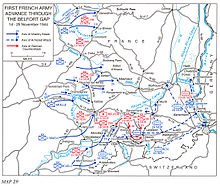Fight for Alsace and Lorraine (1944)
| date | November 12 to December 19, 1944 |
|---|---|
| place | Alsace , Lorraine |
| output | Breakthrough of the Allies to the Upper Rhine |
| Parties to the conflict | |
|---|---|
| Commander | |
| Troop strength | |
| nn | nn |
1944: Overlord · Dragoon · Mons · Market Garden · Scheldt estuary · Aachen · Hürtgenwald · Queen · Alsace-Lorraine · Ardennes
1945: Nordwind · Bodenplatte · Blackcock · Colmar · Veritable · Grenade · Blockbuster · Lumberjack · Undertone · Plunder · Würzburg · Ruhrkessel · Nuremberg
The fighting for the French territories of Alsace and Lorraine in World War II took place at the end of 1944.
prehistory
After Allied troops had pushed the Wehrmacht out of large parts of France in August and September 1944 , the Allies' rapid advance came to a halt in mid-September on the Belgian-Dutch and Belgian-German border as well as on the Moselle and its tributaries. Also, the Alsace and Lorraine were initially in German hands, some sub-regions even until March 1945. Since the SHAEF headquarters first with the Rhine delta and Aachen pursued other priorities, there were 1944 only local fighting in September and October.
Fighting
At the insistence of France and in the hope of breaking into the Siegfried Line here and avoiding high losses as in the previous battles, SHAEF nevertheless decided to launch an offensive in this section, with large parts from mid-November to mid-December 1944 of Alsace and Lorraine could be conquered. On November 12, 1944, the 6th US Army Group, in cooperation with the 3rd US Army, launched an offensive on both sides of the Vosges . The Allied armies broke through the Zaberner Steige and the Burgundian Gate and reached the river bank in the Upper Rhine Graben on November 19 near Mulhouse and on November 23 near Strasbourg .
In early to mid-December they had largely pushed the German 1st Army back north from the Lower Alsace and included parts of the 19th Army in the Alsace bridgehead . The latter was taken out of Army Group G on December 2, 1944 and transferred to the newly formed Upper Rhine Army Group , whose command was given to Himmler on December 10 and which was directly subordinate to the Fuehrer's headquarters . On December 19, Wehrmacht soldiers cleared the Simserhof artillery plant ( belonging to the Maginot Line ) (near Bitche , 30 km south of Zweibrücken); allied soldiers occupied it.
The Battle of the Bulge forced the Allied troops on December 19 to break off the attacks and to regroup the 3rd US Army . As a result, there was military calm in Alsace and Lorraine until the Wehrmacht there began Operation Nordwind on December 31, 1944 , their last offensive on the western front .
After the fighting
The Germans ended their company Nordwind on January 25th with some success. They now occupied around 40 percent of Alsace again.
By dodging behind the Moder , the Allied forces gained freedom of action for an attack on what was now the German bridgehead in Alsace, which led to the breaking up of several German divisions in the Vosges and the removal of this bridgehead on February 9, 1945. During this period, parts of the former Gambsheim bridgehead were recaptured.
The German troops there only cleared the area between Moder and the German starting positions during the subsequent Undertone attack (March 15 to 24, 1945).
literature
- Robert Ross Smith, Jeffrey J. Clarke: Riviera To The Rhine. The official US Army History of the Seventh US Army. Diane Pub Co., 1993, ISBN 0-7567-6486-6 .
- Keith Bonn: When the Odds Were Even: The Vosges Mountains Campaign, October 1944 – January 1945 . Presidio Press, 2006, ISBN 0-345-47611-5 .
- John Keegan : The Second World War . Rowohlt Berlin, 2004, ISBN 3-87134-511-3 .
- Steven Zaloga: Operation North Wind 1945 - Hitler's last offensive in the West . Osprey Publishing, 2010, ISBN 978-1-84603-683-5 .
- Friedrich Wilhelm von Mellenthin : Panzer Battles, 1939–1945 . Futura Publications, 1977, ISBN 0-86007-454-4 (1st edition 1956).
- David Colley: Decision at Strasbourg: Ike's Strategic Mistake to Halt the Sixth Army Group at the Rhine in 1944 . US Naval Inst Pr, 2008, ISBN 978-1-59114-133-4 .
- Rolf-Dieter Müller (Ed.): The German Reich and the Second World War. Volume 10/1: The military overthrow of the Wehrmacht. DVA, Munich 2008, ISBN 978-3-421-06237-6 .
Web links
- 14th Armored Division Combat History
- Smith and Clarke: Riviera To The Rhine. The official US Army History of the Seventh US Army
Footnotes
- ↑ Bonn: When the odds were even p. 103 ff.
- ^ Bonn: When the odds were even p. 147 ff.
- ^ Zaloga: Operation North Wind 1945. p. 19.
- ↑ US Army in WW II - Rviera to the Rhine . Cape. 27: Northwind. P. 492.
- ↑ Cf. Zaloga: Operation Nordwind 1945. P. 85.
- ^ Zaloga: Operation North Wind 1945. which only suggests this in several places.

